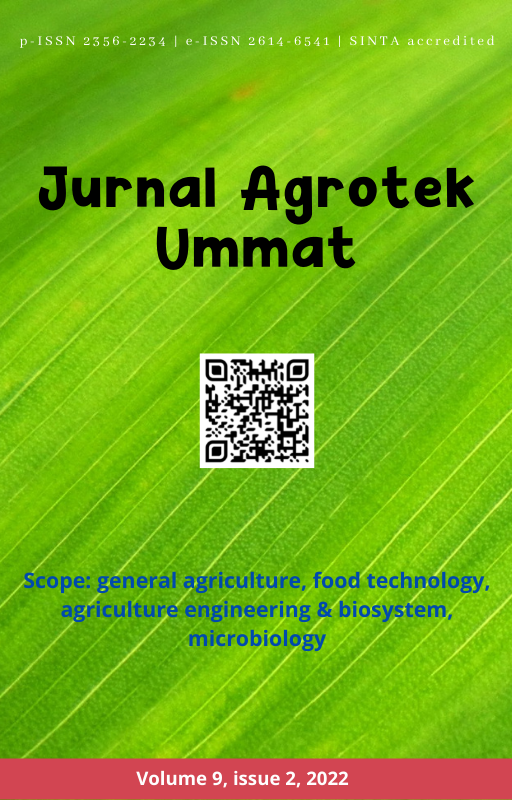Growth response and yield of sweet corn (Zea mays saccharata) of orrin liquid organic fertilizer
DOI:
https://doi.org/10.31764/jau.v9i2.8263Keywords:
Frequency, Sweet Corn, Concentration, Orrin Liquid FertilizerAbstract
Orrin liquid organic fertilizer (POC) is one of the organic fertilizers that contain essential nutrients, both macro and micro, and Si elements which are readily available for plants. This study aims to determine the effect of concentration and frequency of Orrin liquid organic fertilizer on the growth and yield of sweet corn plants. The experiment was conducted on the land of a farmer in Tembeng Putik Village, Wanasaba District, East Lombok Regency. The method used is a Randomized Block Design (RBD) with a factorial pattern consisting of 2 factors: the first factor was concentration (k) Orrin Liquid Organic Fertilizer consisting of 4 levels, namely (0, 5,10, and 15) ml L-1, and the second factor was frequency (f) consisting of 2 levels, namely f1 = age of 2 and 4 weeks after planting (WAP), f2 = age of 2, 4 and 6(WAP). combinations were from these two factors were obtained 8 treatment combinations and each treatment was repeated 3 times. Data obtained were analyzed using analysis of variance at a 5% significance level, and for significantly different treatments tested further with the Honestly Significant Difference test at the same level. The results showed that there was no interaction difference between the concentration and frequency of Orrin liquid organic fertilizer on all variables tested. Orrin liquid organic fertilizer concentration did not affect all the variables tested except for the shoot fresh weight. While the frequency of Orrin liquid organic fertilizer does not affect all the variables tested. Further research is needed on the effectiveness and efficiency of using POC Orrin for the corn which can be used as an alternative to environmentally friendly fertilizers
References
Armansyah, W. dan Kristina N. (2010). Sosialisasi Penanaman Jagung Manis di Kota Padang.Warta Pengabdian Andalas. 16(24):9-20.
Badan Pusat Statistik. (2015). Luas panen, Produktivitas dan Produksi Jagung Manis menurut Provinsi. http://www.bps.go.id [28/11/2008].
Dhaliwal, D. S., Ainsworth, E. A., & Williams, M. M. (2021). Historical Trends in Sweet Corn Plant Density Tolerance Using Era Hybrids (1930–2010s). Frontiers in Plant Science, 12(September), 1–10. https://doi.org/10.3389/fpls.2021.707852
Made, U. (2010). Respons Berbagai Populasi Tanaman Jagung (Zea mays saccharata Sturt.) terhadap Pemberian Pupuk Urea. J. Agroland, 17(2), 138–143.
Muhammad, L., & Sahiran, A. (2019). Plant Performance on Several Maize-Soybean Intercropping Patterns Inoculated With Arbuscular Mycorrhizal Fungi and Organic Matter in the Suboptimal Land of North Lombok. 4(11).
Mulyati, Baharuddin, A. B., & Tejowulan, R. S. (2021). Improving Maize (Zea mays L.) growth and yield by the application of inorganic and organic fertilizers plus. IOP Conference Series: Earth and Environmental Science, 712(1), 1–8. https://doi.org/10.1088/1755-1315/712/1/012027
Nugroho, D. B., Maghpoer, M. D., & Herlina, N. (2017). Pertumbuhan dan Hasil Tanaman Selada akibat Pemberian Biourine Sapi dan Kascing. Jurnal Produksi Tanaman, 5(4), 600–607.
Oviyanti, F., Syarifah, S., & Hidayah, N. (2016). Pengaruh pemberian pupuk organik cair daun gamal (Gliricidia sepium (Jacq.) Kunth ex Walp.) terhadap pertumbuhan tanaman sawi (Brassica juncea L.). Jurnal Biota, 2(1), 61–67. http://jurnal.radenfatah.ac.id/index.php/biota/article/view/531
Rizki, M., Andasuryani, & Yanti, D. (2016). Rancang Bangun Alat Tugal Semi Mekanis Penanam Biji Wortel (Daucus Carota). Universitas Andalas (Skripsi). Fakultas Teknologi Pertanian. Universitas Andalas Malang: Padang.
Syofia, I., Munar, A., & Sofyan, M. (2014). Pengaruh Pupuk Organik Cair Terhadap Pertumbuhan dan Hasil Dua Varietas Tanaman Jagung Manis (Zea mays saccharataSturt). Jurnal Agrium, 18(3), 208–218.
Widodo, W., Sinambela, A. M. L., & Simanihuruk, B. W. (2018). Growth and Yield Response of Sweet Corn (Zea Mays Saccharata Sturt) on Some Green Manure Tithonia Diversifolia and Dose of Em4. Akta Agrosia, 21(2), 61–66. https://doi.org/10.31186/aa.21.2.33-38
Firmansyah, M. A. (2010). Rekomen-dasi Pemupukan Umum Karet, Kelapa Sawit, Kopi dan Kakao. Litbang.
Hadisuwito, S. (2008). Membuat Pupuk Kompos Cair.PT Agromedia Pustaka. Jakarta. 50 hal.
Inal A, Gunes A, Zhang F and Cakmak I (2007). Peanut/ maize inter-cropping induced changes in rhizosphere and nutrient concentrations in shoots. Plant Physiology and Biochemistry 45: 350- 356inal
Marschner, H. (2002). Mineral Nutrition of Higher Plants. The Second Edition. Academic Press. London.
Martajaya, M. (2009). Metode Budidaya Organik Tanaman Jagung Manis di Tlogomas, Malang. Jurnal Pembangunan dan Alam Lestari 1 (1): 1-14.
Mulyati, Lolita, E.S. (2006). Pupuk dan Pemupukan. Universiras Mataram Press. Mataram.
Priyono, J. (2010). Leafleat Pupuk Silikat Cair Orrin. PT JIA Agro Indonesia.
Rubatzky VE, dan Yamaguchi M. (1998). Sayuran Dunia: Prinsip, Produksi, dan Gizi. Herison C, Penerjemah. Bandung (ID): ITB Pr. Terjemahan dari World Vegeta-bles: Principles, Production, and Nutritive Values.
Sahiran, L.M.A., Astiko, W., and Mulyati. (2019). Plant Performance on Several Maize-Soybean Inter-cropping Patterns Inoculated with Arbuscular Mycorrhizal Fungi and Organic Matter in the Sub-optimal Land of North Lombok. IJISRT, vol 4 (2) 165-170).
Sunarminto, B.H. (2015). Pertanian Terpadu: Untuk mendukung Kedaulatan pangan nasional. Cetakan kedua. Gadjah Mada University Press. Yogyakarta.
Sutapraja, S dan Hilman Y. (1994). Pengaruh Konsentrasi Pupuk Daun Tress Terhadap Pertum-buhan dan Hasil Tanaman Bawang Putih (Allium Sativum L.) Kultivar Lumbu Hijau.
Syafruddin, & Fadhly, A. F. (2004). Budidaya Jagung Untuk Benih. Pelatihan Peningkatan Kemam- puan Petugas Produksi Benih Serrelia. 12-16.
Diversifolia and Dose od EM4. J of Akta Agrosia. Vol 21 (2): 62-66.
Yuwono, T. (2006). Bioteknologi Pertanian. Seri Pertanian. Gadjah Mada University Press. 66 hal.
Downloads
Published
Issue
Section
License
Authors who publish articles in Jurnal Agrotek Ummatagree to the following terms:- Authors retain copyright of the article and grant the journal right of first publication with the work simultaneously licensed under a CC-BY-SA or The Creative Commons Attribution–ShareAlike License.
- Authors are able to enter into separate, additional contractual arrangements for the non-exclusive distribution of the journal's published version of the work (e.g., post it to an institutional repository or publish it in a book), with an acknowledgment of its initial publication in this journal.
- Authors are permitted and encouraged to post their work online (e.g., in institutional repositories or on their website) prior to and during the submission process, as it can lead to productive exchanges, as well as earlier and greater citation of published work (See The Effect of Open Access).

